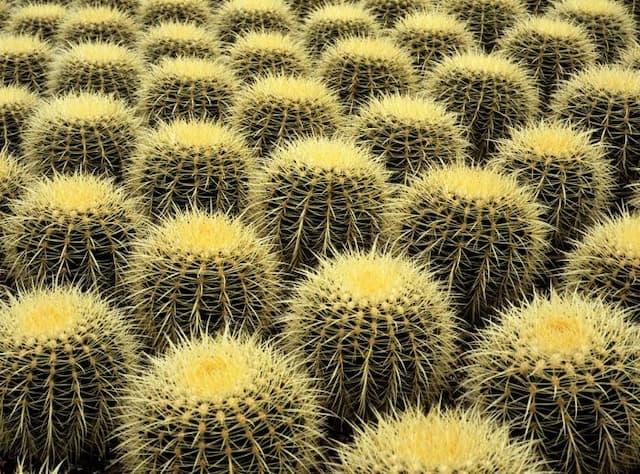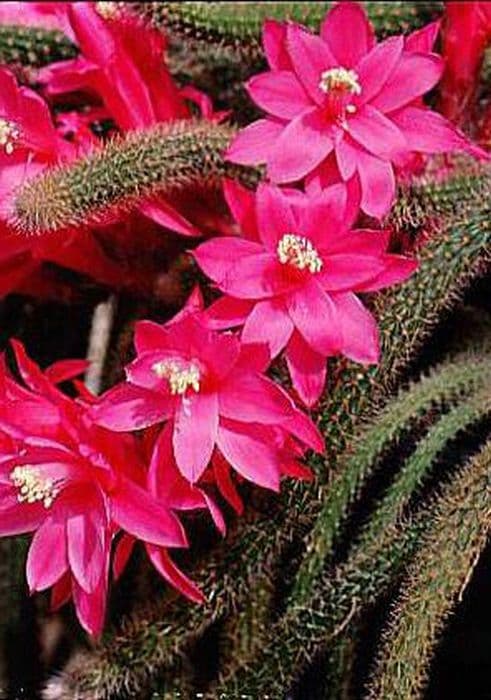Plains Prickly Pear Opuntia polyacantha

ABOUT
The common name for Opuntia polyacantha is plains prickly pear. This plant sports a unique and rugged appearance typical of cacti, with its green, flat, fleshy pads that are rounded or oval in shape, often arranged in a clustered form. These pads serve as the stems and are dotted with small, raised bumps known as areoles. From each areole, it sprouts clusters of sharp spines, which can range in color from white to yellow, red, or brown, and provide the plant with a formidable defense against herbivores. Between the spines, the plains prickly pear may also feature small, hair-like structures, which can be irritating to the skin if touched. During the blooming period, the plant produces lovely flowers that can be yellow, orange, or sometimes red, lending a striking contrast against the green of the pads. The blossoms typically appear at the edges of the pads, giving the plant an even more distinctive look. Following the flowering, the plant may bear edible fruits that turn a rich, purplish color when ripe, adding to the visual interest of this hardy plant.
About this plant
 Names
NamesFamily
Cactaceae.
Synonyms
Plains Prickly Pear, Hairspine Cactus, Panhandle Prickly Pear, Starvation Cactus, Desert Prickly Pear, El Paso Prickly Pear.
Common names
Opuntia missouriensis, Opuntia rhodantha, Opuntia polyacantha var. arenaria, Opuntia polyacantha var. hystricina, Opuntia polyacantha var. nicholii, Opuntia polyacantha var. polyacantha, Opuntia polyacantha var. rhodantha, Opuntia polyacantha var. trichophora, Opuntia rhodantha var. arenaria, Opuntia rhodantha var. rhodantha, Opuntia rhodantha var. trichophora.
 Toxicity
ToxicityTo humans
The plant known as Prickly Pear is not considered toxic to humans. In fact, many parts of the Prickly Pear cactus, including its fruits and pads, are edible and are used in various culinary dishes, especially in Mexican cuisine. However, care should be taken when handling the plant because its spines can cause physical injury, including skin irritation and puncture wounds. If the spines are not properly removed before consumption, they can lead to physical discomfort or injury to the mouth, throat, or digestive tract.
To pets
Prickly Pear is also not recognized as toxic to pets. As with humans, pets may consume parts of this plant without significant risk of poisoning. Nevertheless, the spines of the cactus can be a physical hazard, potentially causing injuries to your pets such as puncture wounds, irritation, or damage to the mouth and digestive system if ingested. It is wise to prevent pets from accessing the plant to avoid these physical injuries.
 Characteristics
CharacteristicsLife cycle
Perennials
Foliage type
Evergreen
Color of leaves
Green
Flower color
Varies
Height
6 inches (15 cm)
Spread
2 feet (60 cm)
Plant type
Cactus
Hardiness zones
5
Native area
North America
Benefits
 General Benefits
General Benefits- Drought Tolerance: Opuntia polyacantha, commonly known as the Plains Prickly Pear, is highly drought-tolerant, making it suitable for xeriscaping and water-efficient gardens.
- Soil Erosion Control: This plant's extensive root system helps to stabilize the soil, reducing erosion in arid habitats.
- Low Maintenance: Plains Prickly Pear requires minimal care once established, as it is suited to dry, poor soils and does not require regular watering or fertilizing.
- Habitat for Wildlife: The plant provides shelter and food for wildlife such as birds, which may nest in its branches, and insects that feed on its nectar and pollen.
- Ornamental Value: With its distinctive pads and bright yellow flowers, the Plains Prickly Pear adds visual interest to landscapes and gardens.
- Economic Use: The pads (nopales) of some Opuntia species are edible and consumed in various cuisines, though this aspect might vary locally for Opuntia polyacantha.
- Winter Interest: During winter when many plants die back, the Plains Prickly Pear maintains its structure, providing year-round interest in the garden.
 Medical Properties
Medical Properties- Anti-inflammatory: Opuntia polyacantha, commonly known as prickly pear, has been reported to have anti-inflammatory properties, potentially beneficial in reducing inflammation.
- Antioxidant: The plant is known to contain antioxidants, which may help in protecting cells from damage caused by free radicals.
- Antiviral: Some studies suggest that extracts from Opuntia species might have antiviral capabilities, though more research is needed.
- Wound healing: The mucilage and other compounds found in prickly pear are believed to aid in the healing of minor wounds.
- Diabetes management: There is some evidence indicating that prickly pear can help regulate blood sugar levels, although it should not replace conventional treatment.
- Cholesterol control: Components in Opuntia polyacantha may help in reducing cholesterol levels, as a part of a healthy diet and lifestyle.
- Gastroprotective effects: The plant might have beneficial effects on the gastrointestinal system, helping to protect the stomach lining.
 Air-purifying Qualities
Air-purifying QualitiesThis plant is not specifically known for air purifying qualities.
 Other Uses
Other Uses- Opuntia polyacantha, commonly known as the prickly pear, can be used to create natural barriers or fences due to its dense and spiky growth habit, deterring animals and unauthorized access.
- The prickly pear is employed in dye production, with its fruits and pads providing natural pigments for coloring textiles and other materials.
- The woody parts of the plant are sometimes used in traditional crafts, like making small furniture or decorative items, especially in regions where it grows abundantly.
- In some areas, the dried pads of prickly pear can serve as an alternative fuel source, being used similarly to wood or coal for heating and cooking.
- The mucilage extracted from prickly pear pads is sometimes used as a natural adhesive or binding agent in various applications.
- Prickly pear fruit juice and pulp can be used to make jelly and candies, offering a unique flavor distinct from more common fruit preserves.
- The fibers found in Opuntia polyacantha can be processed and used in paper making, adding a distinctive texture and quality to the finished product.
- In some rural communities, prickly pear serves as emergency fodder for livestock, particularly during droughts when other food sources are scarce.
- Because of their sturdy nature, prickly pear pads can be used as temporary shingles or building materials for rudimentary shelters or structures.
- The plant's ability to stabilize soil and prevent erosion makes it a valuable tool in land reclamation and environmental restoration projects.
Interesting Facts
 Feng Shui
Feng ShuiThe Prickly Pear is not used in Feng Shui practice.
 Zodiac Sign Compitability
Zodiac Sign CompitabilityThe Prickly Pear is not used in astrology practice.
 Plant Symbolism
Plant Symbolism- Resilience: The prickly pear cactus, which Opuntia polyacantha is commonly known as, survives in arid and tough environments, representing the ability to withstand difficult conditions and bounce back.
- Adaptation: Its ability to thrive in desolate areas symbolizes adaptability and the importance of adjusting to changing circumstances.
- Protection: The spines of the prickly pear defend it against predators, symbolizing self-defense and the necessity of setting boundaries.
- Water Conservation: Prickly pears can store water in their fleshy pads, symbolizing resourcefulness and the importance of conserving precious resources.
- Endurance: The long lifespan of the prickly pear cactus symbolizes endurance and the ability to persist over time.
 Water
WaterThe Plains Prickly Pear should be watered deeply but infrequently. During the growing season, water the plant every 2-3 weeks with enough water to soak the soil, which typically means using approximately one gallon per square foot every time you water. Allow the soil to dry out completely between waterings; in winter, reduce watering to once a month. Overwatering can lead to root rot, so it is crucial to ensure proper drainage. The amount of water needed might be less in climates with higher humidity or during periods of rainfall.
 Light
LightThe Plains Prickly Pear thrives in full sun conditions. It should be placed in a location where it receives at least 6 hours of direct sunlight daily. Avoiding shaded areas is essential to promote healthy growth and blooming. Outdoor plants will perform best when they have unobstructed access to sunlight.
 Temperature
TemperatureThe Plains Prickly Pear is tolerant of a broad range of temperatures, from a maximum of about 100 degrees Fahrenheit down to as low as 10 degrees Fahrenheit. Its ideal growing temperatures fall between 70 and 80 degrees Fahrenheit. Extreme cold or frost can damage the plant, especially if it's prolonged, so ensure it is protected or moved indoors during harsh winter conditions.
 Pruning
PruningThe Plains Prickly Pear may require pruning to remove damaged or diseased pads, control its size, or shape the plant. Pruning is best done in late spring when the plant begins its active growth. Cut back pads at the joint using clean, sharp tools. Pruning every year or two is typically sufficient, but always inspect the plant regularly for any signs of damage that may need attention.
 Cleaning
CleaningAs needed
 Soil
SoilThe best soil mix for the Plains Prickly Pear (Opuntia polyacantha) is a well-draining cactus mix, combined with perlite or coarse sand to enhance drainage. The soil pH should ideally be between 6.0 to 7.5.
 Repotting
RepottingPlains Prickly Pear should be repotted every 2-3 years or when it outgrows its pot, to provide fresh nutrients and prevent root crowding.
 Humidity & Misting
Humidity & MistingPlains Prickly Pear thrives in low humidity conditions typical of arid and semi-arid climates; it does not require high humidity levels.
 Suitable locations
Suitable locationsIndoor
Place in sunny spot, minimal water, well-draining soil.
Outdoor
Full sun, well-draining soil, protect from heavy snow.
Hardiness zone
4-9 USDA
 Life cycle
Life cycleOpuntia polyacantha, commonly known as plains pricklypear, starts its life cycle with seed germination, which requires well-draining soil and temperatures between 70-100°F (21-37°C). Seedlings establish themselves with a taproot and begin to grow flattened, fleshy pads that function as leaves. These pads, called cladodes, photosynthesize and can also produce new segments as the plant matures. As a perennial, the plains pricklypear produces bright yellow flowers typically during the spring to early summer, which are pollinated by insects, birds, and small mammals. Following pollination, the plant develops reddish-purple fruits, known as tunas, which contain seeds that can disperse for new plant growth. With the ability to store water in its pads, Opuntia polyacantha is drought-resistant and can live many years, continuously growing new pads and repeating the flowering and fruiting cycle in its arid and semi-arid habitats.
 Propogation
PropogationPropogation time
Spring to Summer
The most popular method of propagation for the Opuntia polyacantha, commonly known as the Plains Prickly Pear, is through vegetative means, specifically by using its pads or segments. To propagate, one would carefully remove a healthy pad from the mother plant, and then allow the cut end to callous over for several days to a week. Once the cut has dried and formed a callous, the pad can be placed on top of a well-draining soil mix and anchored lightly so that the base is in contact with the soil. Watering should be minimal, just enough to keep the soil slightly moist, until roots have developed which usually occurs in a few weeks. This method is straightforward and efficient, harnessing the plant's natural propensity to root and grow from cut segments.








